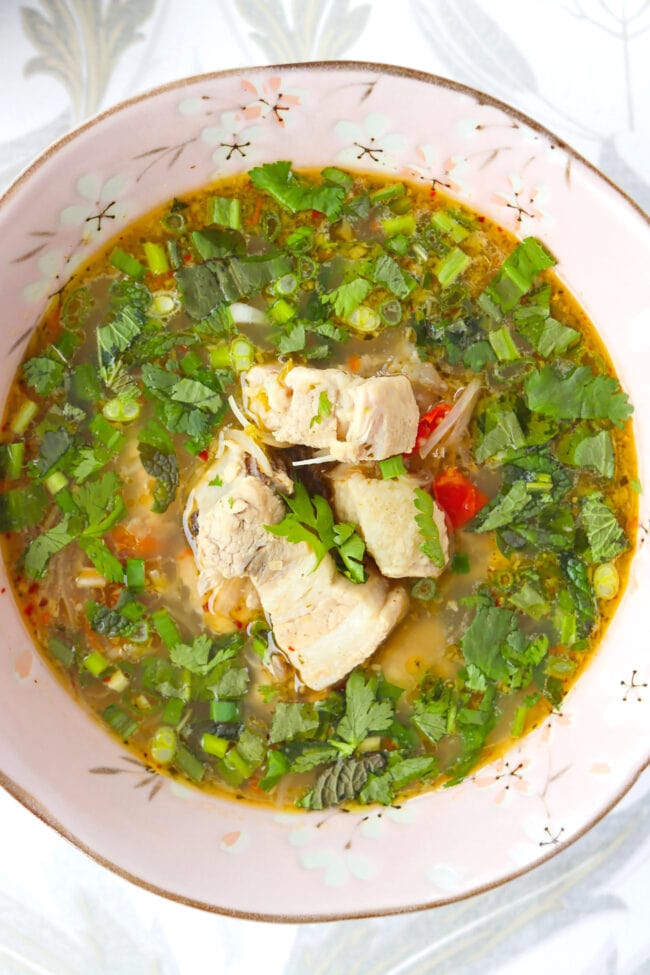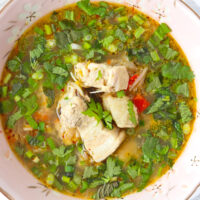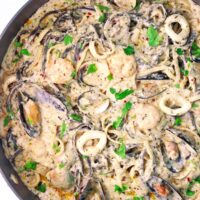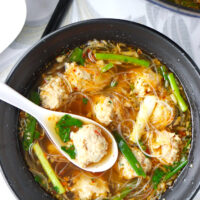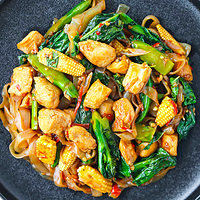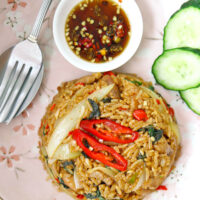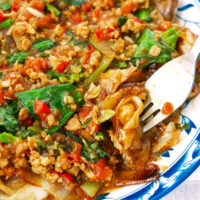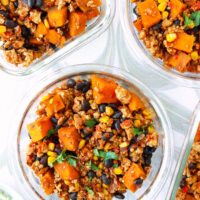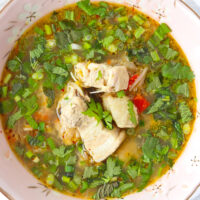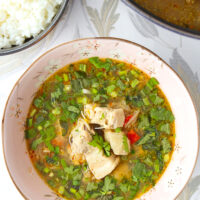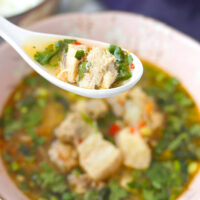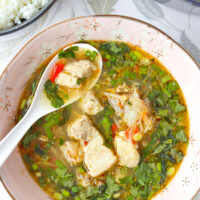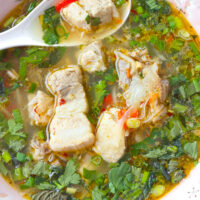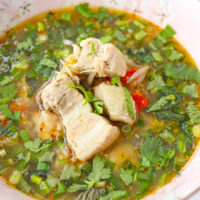Thai Spicy Pork Rib Soup
This post contains affiliate links.
This Thai Spicy Pork Rib Soup boasts a delicious hot and sour broth that is infused with plenty of fragrant aromatics and herbs. It’s easy to make, full of juicy and tender pork spare ribs, and super warming and comforting on a chilly fall or winter day!
Spicy, sour, and tender pork spare ribs meat in a delicious and fragrant herbal broth. Yup, that sums up this Thai Spicy Pork Rib Soup (known as Tom Saap in Thai) perfectly! ❤️
I first tried this soup at a small outdoor restaurant in Bangkok back in 2018, and immediately fell in love with it. It’s perfectly balanced with sour and salty notes. However, when it comes to the heat factor, this beauty is incredibly hot and spicy! (Though you can of course always use less chilies to make it milder if you like. 🙂 )
This soup truly is the definition of HOT because it has plenty of fiery hot Prik Kee Nu green chilies – my favorite type of Thai chili! If you’ve been a reader for a while now, you know that I love to incorporate this chili in any Thai dish, be it Pad See Ew (Thai Rice Noodles Stir-fry), spicy-sweet and velvety Thai Panang Chicken Curry, or even this mouthwatering Thai Eggplant Stir-fry!
But back to this soup. We NEED to talk about the meat. The incredibly tender pork spare ribs meat that practically falls off the bone with the slight pull of a fork – a result from gentle simmering for some time in the herbal broth – makes everything about this flavorful soup simply just heavenly. 😌
It’s the perfect soup for chilly days or when you’re down with a cold, and I think you’re going to love all of its delicious flavors!
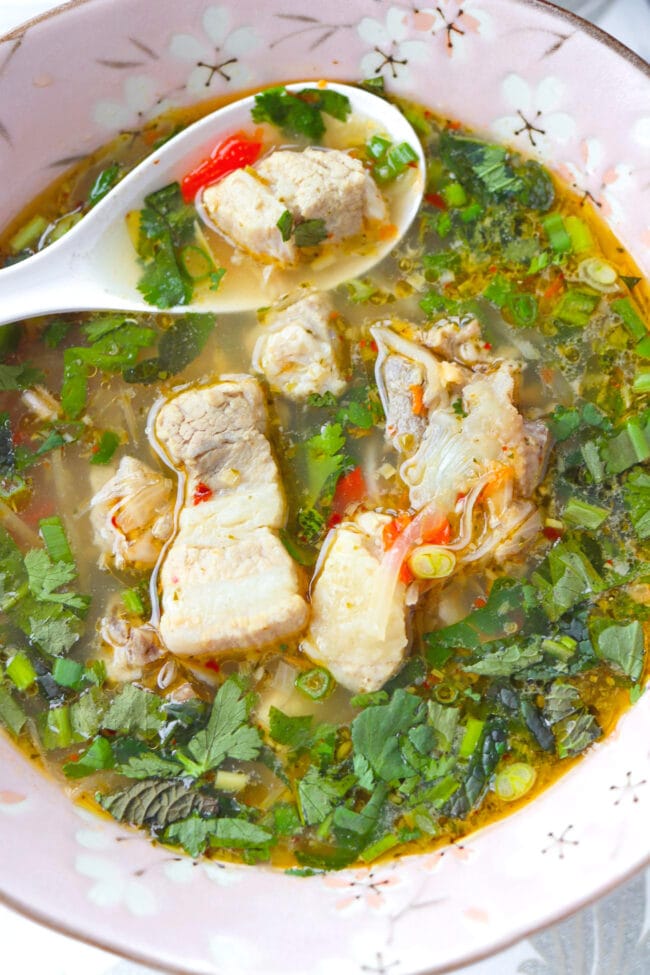
Why This Recipe Works
- Jam-packed with flavor! It’s full of bright herbal flavors, and delicious hot and sour notes thanks to fragrant Thai aromatics, plenty of fresh hot chilies, and tangy lime juice!
- Easy and straightforward to make. Even though it does take time to simmer the meat in the broth so that it becomes wonderfully tender, the actual active cooking time is minimal.
- No straining of the broth required. Finely mincing the lemongrass and makrut lime leaves allows them to become soft enough to be ingested. There’s no need to strain them out of the broth, and you can enjoy their beautiful herbal flavors to the max.
- Warming and comforting meal. It’s perfect for chilly weather, and guaranteed to warm up your insides!
- Versatile. You can enjoy it on its own as a light and simple lunch, or with some steamed rice for a filling dinner.
Ingredient Notes
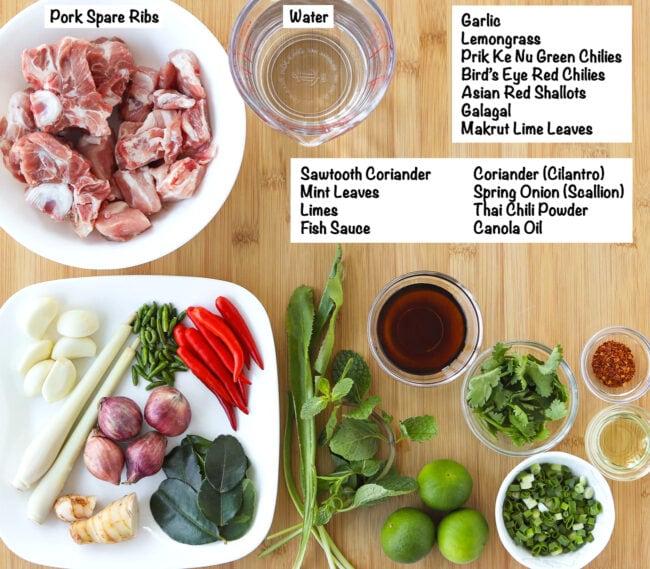
- Pork Spare Ribs: I used a combination of pork spare ribs and front spare ribs and purchased them in packages at a supermarket here in Hong Kong. You can use just spare ribs or even pork neck bones if you like.
- Galangal: This is similar to ginger in appearance, but it has a pale, pinkish color instead. It has a citrusy sweet flavor and floral aroma. Look for it at a Thai grocery store, or an Asian supermarket if you’re based outside of Asia. Substitute with a tablespoon of thinly sliced ginger if unavailable.
- Lemongrass: Substitute with 2 tablespoons of lemongrass paste if unavailable.
- Makrut Lime Leaves: These fragrant leaves add a citrusy sweet flavor and aroma to the soup. They’re usually torn into pieces and added to flavor the broth, then strained/picked out before serving. Sometimes the chef won’t strain the broth, and people will simply leave them at the bottom of their soup bowl. However, I prefer to finely mince the leaves into a fine powder like I do in my Thai Glass Noodle Soup. This way you can eat it without any off-putting mouthfeel, and fully enjoy the delicious flavors that it infuses the soup to the max!
- Bird’s Eye Red Chilies: Or you can use any other small hot red chilies in your area. Adjust quantity to taste based on your heat level preference.
- Prik Kee Nu Green Chilies: Or use any other VERY hot green chilies. These tiny Thai chilies are incredibly hot, so use with caution and adjust the quantity to taste.
- Canola Oil: Or any other neutral flavored cooking oil.
- Fish Sauce: To season the broth with salty umami notes.
- Limes: For freshly squeezed lime juice, and to add delicious sour notes to the broth. Feel free to use more or less to taste.
- Thai Chili Powder (optional): For more heat if desired. Leave it out if you feel the fresh chilies will add enough heat to the broth for your taste.
- Fresh herbs: An essential part of this soup is garnishing it with plenty of fresh herbs. Sawtooth coriander is also known as culantro (sometimes called Thai coriander) and commonly used in Thai cooking in dishes like Laab (Larb). It can be tricky to find outside of Asia, but you can try searching for it at a Southeast Asian, Vietnamese, or Thai specialty ingredients store. If unavailable, simply use regular chopped coriander (cilantro). Other garnishes that I use and highly recommend are fresh mint leaves and spring onion (scallion).
- To serve: Serve the soup with warm steamed rice for a nice and filling meal, or enjoy it on its own.
Full ingredient list and amounts are in the recipe card below.
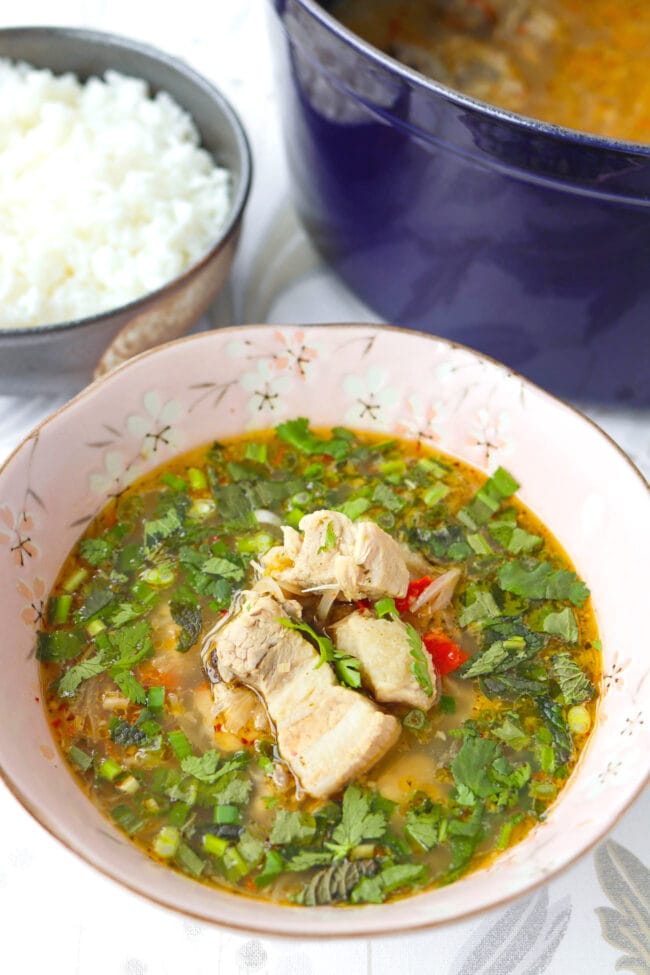
How to Make Thai Spicy Pork Rib Soup
1. Cook the ribs. Add the pork ribs, galangal, and water to a large Dutch oven or stockpot. Bring the water to a boil, then reduce the heat and skim off the scum that forms using a fine mesh strainer. Cover the pot, leaving a small opening so that the water doesn’t boil too rapidly. Simmer on medium-low for 1 hour and 45 minutes, skimming off the scum that forms periodically, or until the pork is tender.
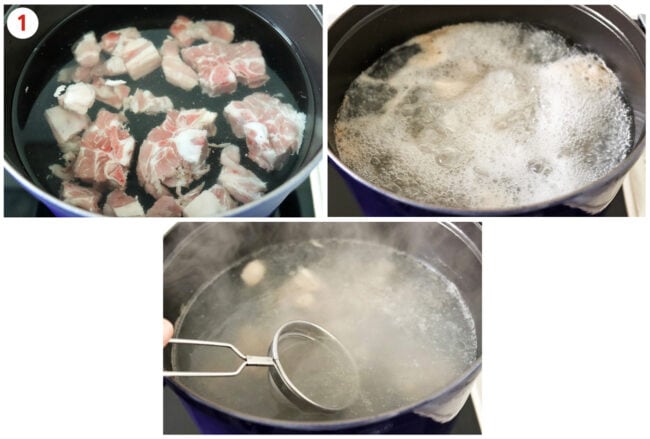
2. Sauté the shallots and garlic chili paste: Heat canola oil in a separate nonstick skillet or frying pan. Add the shallots and sauté for a few seconds, then add the smashed garlic and chilies and sauté for a minute until fragrant. Switch off the heat and set aside.
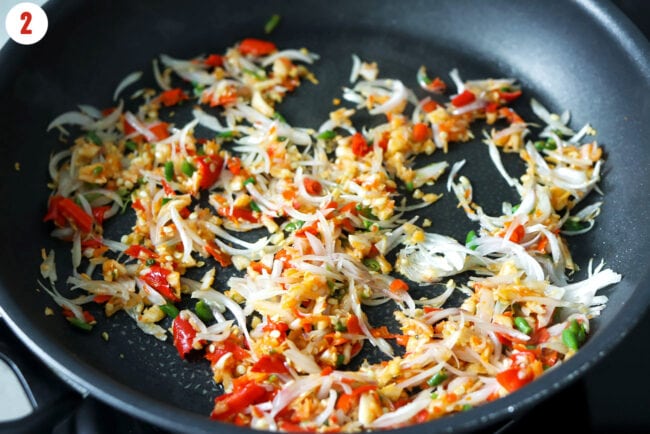
3. Add aromatics and seasonings. Once the pork is tender, skim the broth again to get rid of any particles and excess grease floating at the top. Add the sauteed aromatics from the skillet, along with finely minced lemongrass and makrut lime leaves. Simmer for a few minutes, then season the broth with fish sauce, lime juice, and Thai chili powder (if using). Simmer for another minute or so, then give the broth a taste and adjust seasonings if needed. Switch off the heat.
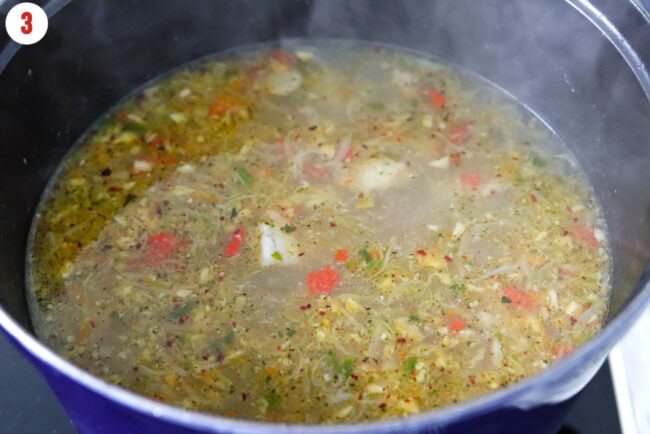
4. Serve! Divide the pork rib soup evenly into bowls. Top with chopped sawtooth coriander (and/or regular coriander), mint leaves, spring onion, and sliced Bird’s Eye red or Prik Kee Nu chilies for an extra kick of heat! Then serve hot with lime wedges for squeezing and some warm steamed rice if desired!
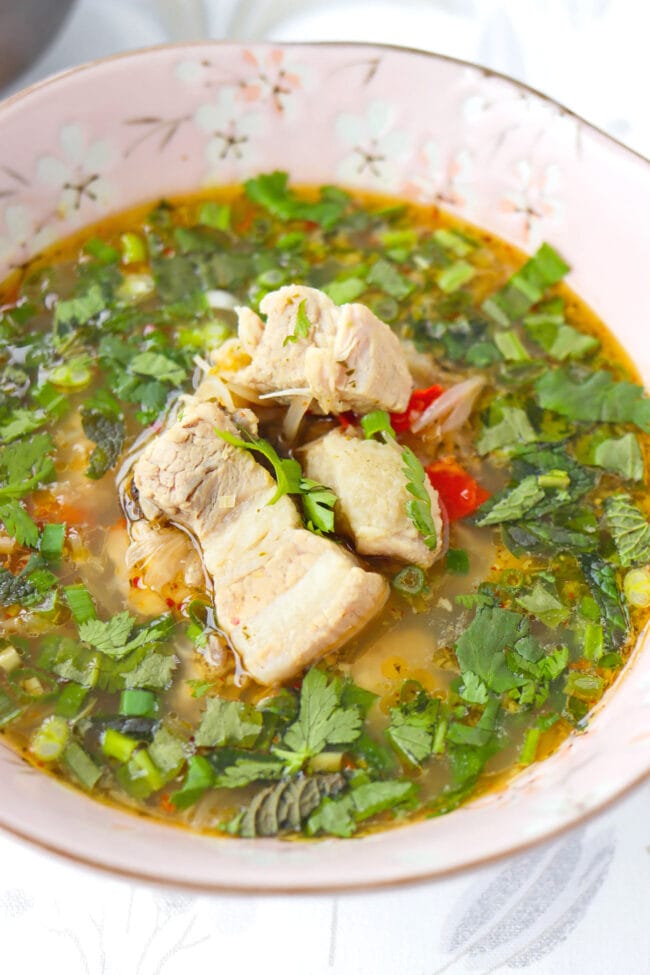
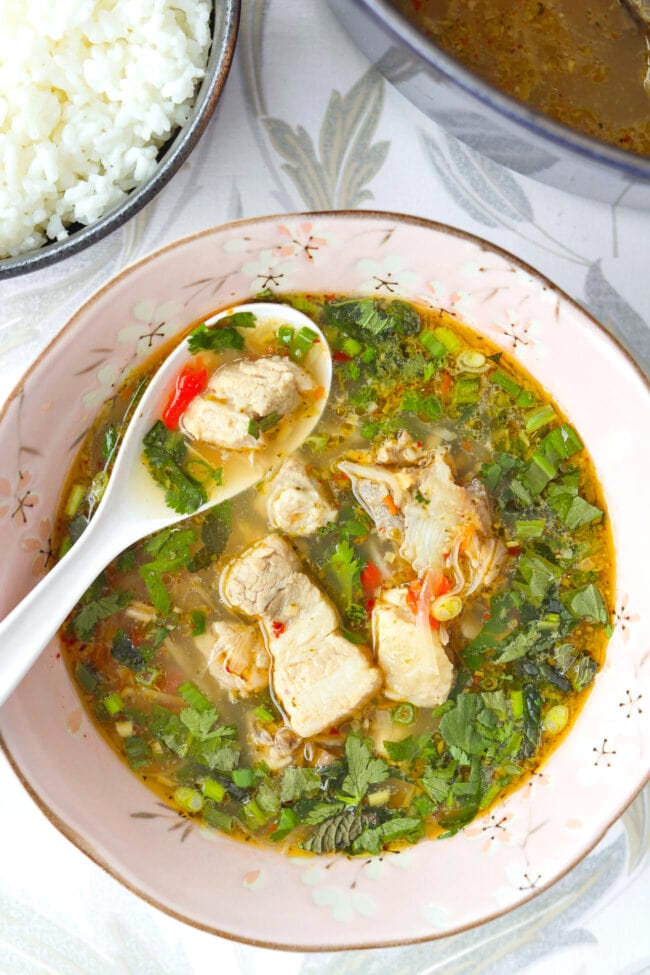
Full detailed instructions are in the recipe card below.
Cook’s Tips
- Ask your butcher to cut the ribs into 2-inch pieces for you. Alternatively, buy pre-cut ribs for soup in packages at an Asian supermarket.
- Adjust spice level to taste by using as many or as few chilies you like. Note that this soup is meant to be very spicy, but you can adjust the quantity of chilies you use to taste. Prik Kee Nu green chilies are fiery hot, so use less or omit them for a slightly milder flavored broth.
- Skim the scum from the broth well. You don’t want gritty boney or scum parts floating in the delicious broth at the end. Use a fine mesh strainer and spoon if needed to get rid of the scum.
- Avoid eating the galangal. It is mainly used for flavoring the broth and will be tough to chew on.
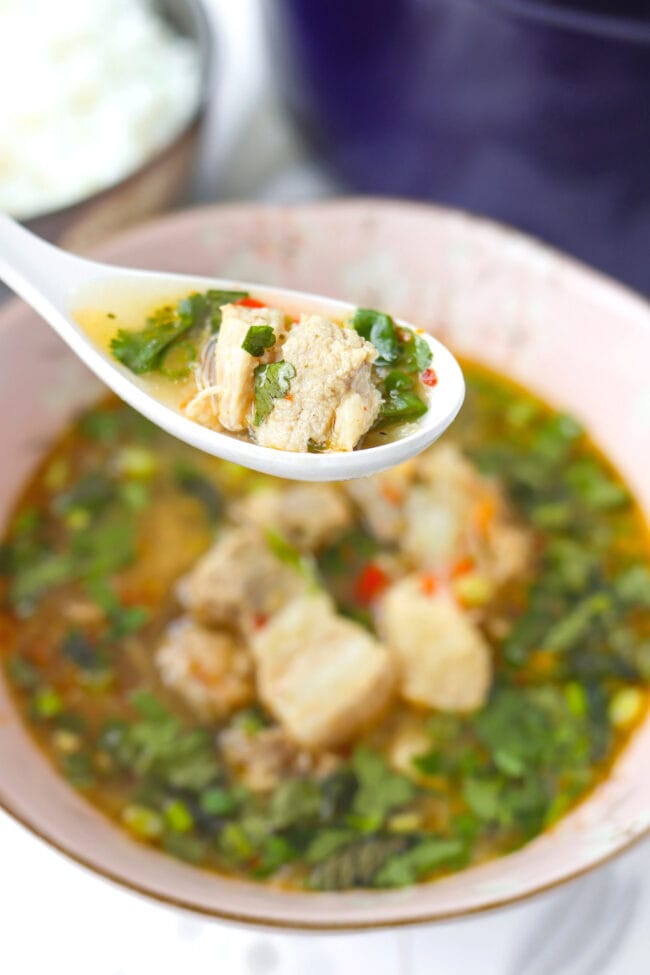
FAQs
This spicy Thai pork rib soup is healthy and full of antioxidants thanks to galangal, garlic, and lemongrass. Galangal aids in reducing inflammation and pain. The spicy fresh chilies also aid in boosting the immune system. While not considered lean meat, the pork spare ribs are a good source of protein and minerals such as iron and zinc. This abundance of fresh herbs and aromatics will help you feel better if you’ve got a cold or your immune system is slightly down.
Sawtooth coriander is a long slender herb with jagged edged leaves, hence its name sawtooth coriander. It is also known as Culantro, and is commonly used in Vietnamese and Thai cooking. Its flavor is similar to that of coriander, but stronger in intensity and pepperiness. You can find it Vietnamese or Thai specialty ingredient stores. After purchasing, store in a tall mason jar filled with one to two inches of water. Cover the jar with a ziplock bag and seal it at the base with a rubber band.
Ribs do become more tender if cooked longer over low heat. If they’re cooked at a too high temperature, they can start to dry out and become tough and chewy.

More Asian Soups
- Thai Glass Noodle Soup
- Spicy Curry Laksa
- Khao Soi Gai (Northern Thai Coconut Curry Noodles Soup with Chicken)
More Western Soups
- Spicy Chicken Enchilada Soup
- Spicy Pumpkin Chicken Tortilla Soup
- Creamy Tomato Basil Tortellini Soup
- Creamy Chicken Mushroom Rice Soup
- Or browse the entire Soups & Chowders recipe collection.
MADE THIS RECIPE? If you make this recipe, leave a comment below and let me know how you liked it! Take a photo and tag it with @thatspicychick on Instagram and hashtag it #thatspicychick and I’ll be sure to share your masterpiece!
STAY CONNECTED! You can also follow me on Pinterest, Facebook or Instagram. Sign up for my email list to get my latest recipe in your inbox weekly!
PrintThai Spicy Pork Rib Soup (Tom Saap)
This Thai Spicy Pork Rib Soup boasts a delicious hot and sour broth that is infused with plenty of fragrant aromatics and herbs. It’s easy to make, full of juicy and tender pork spare ribs, and super warming and comforting!
- Prep Time: 15 minutes
- Cook Time: 1 hour, 45 minutes
- Total Time: 2 hours
- Yield: 4 1x
- Category: Dinner
- Method: Simmer
- Cuisine: Thai
- Diet: Gluten Free
Ingredients
- 680 grams / 1.5 pounds Pork Spare Ribs (I used a combination of pork spare ribs and front spare ribs) – cleaned and rinsed
- 2.5-inch piece Galangal – peeled and thinly sliced
- 9 cups / 4.5 liquid pints Water
- 4 Asian Red Shallots – peeled and thinly sliced (substitute with ½ a small thinly sliced red onion if unavailable)
- 2 Lemongrass stalks – top and bottom woody parts chopped off and discarded, outer tough layers removed, and finely minced (substitute with 2 TBLS lemongrass paste if unavailable)
- 8–10 Makrut Lime Leaves – destemmed and finely minced into a powder
- 6 Garlic Cloves – roughly chopped
- 10 Bird’s Eye Red Chilies (or use any other small hot red chilies), to taste – roughly chopped
- 10–20 Prik Kee Nu Green Chilies (or use any other very hot green chilies), to taste – roughly chopped
- 2 TBLS Canola Oil (or any other neutral flavored cooking oil)
- 3 TBLS Fish Sauce
- 3.5 TBLS freshly squeezed Lime Juice, more or less to taste
- ½ TSP Thai Chili Powder (optional), to taste
To Serve:
- ½ cup Sawtooth Coriander – roughly chopped
- 1/3 cup Coriander (Cilantro) – chopped
- 1/3 cup fresh Mint Leaves – chopped
- 2 Spring Onions (Scallions) – chopped
- 5–6 Bird’s Eye Red or Prik Kee Nu Green Chilies (optional) – sliced
- Lime wedges for squeezing
- Steamed Rice (optional)
Instructions
- Prepare all the ingredients: Clean the pork ribs and rinse well, then cut the ribs through the bone into 2-inch sized pieces. Prepare/chop the galangal, Asian red shallots, lemongrass, makrut lime leaves, garlic, Bird’s Eye red chilies, and Prik Kee Nu green chilies as indicated in the ‘Ingredients’ section. Using a mortar and pestle, pound the garlic and chilies into a coarse paste, then set aside. (Note: If you don’t own a mortar and pestle, smash the garlic and chilies with the flat side of your knife then roughly chop.)
- Cook the ribs: Add the pork ribs, galangal, and 9 cups of water to a large Dutch oven or stockpot. Bring the water to a boil over high heat, then reduce the heat to low and skim off the scum that forms using a fine mesh strainer. Cover the Dutch oven with its lid, leaving a small opening so that the water doesn’t boil too rapidly. Continue gently simmering over medium-low heat for 1 hour and 45 minutes, skimming off the scum that forms periodically, or until the pork is tender.
- Sauté the shallots and garlic chili paste: In a separate medium sized nonstick skillet or frying pan, heat 2 tablespoons of canola oil over medium heat. Once hot, add the shallots and sauté for 30 seconds. Then add the garlic chili paste and sauté for 1 minute, or until fragrant. Switch off the heat and set aside.
- Add aromatics and seasonings: Once the pork is tender, skim off any particles and excess grease floating at the top of the broth. Then add the sautéed shallots and garlic chili paste, lemongrass, and makrut lime leaves. Simmer for 5-7 minutes, then season the soup with fish sauce, lime juice, and Thai chili powder (if using). Simmer for 1-2 minutes, then taste and adjust seasonings if needed by adding more fish sauce or lime juice. Switch off the heat.
- To Serve: Ladle the pork rib soup evenly into bowls. Top with chopped sawtooth coriander (or regular coriander), mint leaves, spring onion, and sliced Bird’s Eye red or Prik Kee Nu Chilies (optional). Serve hot with lime wedges for squeezing and steamed rice if desired.
Notes
- Asian ingredients. Look for galangal, Asian red shallots, lemongrass, makrut lime leaves, Bird’s Eye and Pik Kee Nu green chilies, Thai chili powder, fish sauce, and sawtooth coriander in a Thai speciality ingredients store or an Asian supermarket. Thai Prik Kee Nu chilies may be hard to find outside of Asia, so feel free to substitute with more Bird’s Eye or any other hot red or green chilies you can find in your area. See the post above if you’d like to learn more about each of these ingredients.
- Pork spare ribs. I used a combination of pork spare ribs and front spare ribs and purchased them in packages at a supermarket. You can use just spare ribs or even pork neck bones if you like. Pro-tip: Ask your butcher to cut the ribs into 2-inch pieces for you. Alternatively, buy pre-cut ribs for soup in packages at an Asian supermarket.
- Spice level. Adjust spice level to taste by using as many or as few chilies you like. Note that this soup is meant to be very spicy, but you can adjust the quantity of chilies you use to taste. Prik Kee Nu green chilies are fiery hot, so use less or omit them for a slightly milder flavored broth.
- To make this gluten-free: This soup is naturally gluten-free, but double check the ingredients label for the fish sauce you’re using to ensure it is GF certified.
- Skim the scum from the broth well. You don’t want gritty boney or scum parts floating in the delicious broth at the end and ruining your experience!
- Storing and reheating leftovers. The soup will keep in a sealed airtight container (without garnishes) for 3-5 days. Reheat over medium-high heat in a pot in the stovetop, ladle into bowls, then garnish with the fresh herbs and sliced chilies (if using) right before serving.
Nutrition
- Serving Size: 1 bowl
- Calories: 496
- Sugar: 13.7g
- Sodium: 1451mg
- Fat: 17.5g
- Saturated Fat: 4g
- Unsaturated Fat: 12.2g
- Trans Fat: 0g
- Carbohydrates: 36.8g
- Fiber: 6.3g
- Protein: 42.1g
- Cholesterol: 125.8mg
This post may contain affiliate links. We are a part of the Amazon Services LLC Associates Program, an affiliate advertising program designed to provide a means for us to earn a small commission (at no extra cost to you) by linking to Amazon.com and affiliated sites. The nutritional information provided is approximate and can vary based on several factors. It should only be used as a general guideline. For more information, please see our Disclosure.

